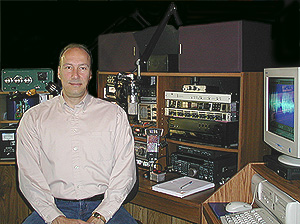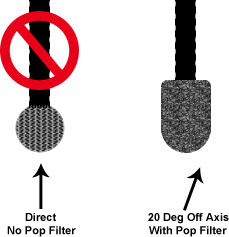
NU9N SSB Audio News Editorial - December, 2004 |
| GOOD MICROPHONE ETIQUETTE  Do
your P's "Pop"? Do your cough's crunch? Does your breathing cause condensation on your mic? You're probably too close and too direct! Do
your P's "Pop"? Do your cough's crunch? Does your breathing cause condensation on your mic? You're probably too close and too direct!Even though good microphone etiquette and technique has probably been beat to death, I believe it is worth covering again for new operators and perhaps old ones that are not educated on the subject simply because no one has ever spent time addressing the issues with them. Note 1: This page will deal ONLY with microphones as they apply to human speech. For musical instrument applications, a whole different set of rules would apply. Note 2: When selecting a microphone type and manufacturer for amateur radio applications, don't worry too much about it's performance, because the real performance hit is going to happen in the transmitter, not the microphone. Any cheap mic with a decent frequency response of 50 Hz ~ 15 kHz will far exceed anything that your transmitter will pass through it's DSP or analog filters anyway. Because there are different types of microphones, i.e. Condensers. Dynamics, Ribbons, etc., there are obviously different ways that microphones should be addressed. There are several variables to consider when determining the proper distance one should have between them and their microphone. Some of the variables include how much "Proximity Effect" will be desired, type of microphone being used, how loud you talk (or laugh), the SPL rating of the microphone, etc... The Two Golden Rules of Good Microphone Technique The two most important things to remember when addressing a microphone, regardless of what kind of mic will be used, are the angle in which you speak into the mic, and the use of a "Wind Screen" or "Pop Filter". See the illustration below:
Changing Your Angle: The idea behind NOT addressing the microphone head-on is keeping the plosive energy ("P" percussion) and highly concentrated air from ever reaching the microphone element. This massive pressure change is normally beyond the SPL (Sound Pressure Level) rating of any microphone and will result in a "Pop" sound that will drive your processing crazy. Use A Windscreen or Pop-Filter! The use of a Pop-Filter or Windscreen will help deflect the remaining concentrated air from reaching the microphone element by redirecting and dispersing the air to the sides. Additionally, a filter will capture breath moisture and protect highly sensitive gold-sputtered condenser elements from potentially damaging effects. Use An Adjustable Mic Boom The convenience of an adjustable microphone boom is essential in making your microphone accessible in many operating positions. Heil Sound offers a good boom system called the PL-2T. It is a "Topless" boom designed to handle microphones up to 3.5 pounds and allows you to place the mic cable inside the boom without having to remove and replace your microphone cable connectors with cables that are already made up. Use A Good Elastic Suspension Microphone Shock Mount System A good shock-mount system is designed to isolate the microphone from the microphone boom thus reducing the noise inherent in moving the boom around and noise associated with vibrations from your desk or other sources in your shack that conduct through the boom to the microphone. Proximity Effect "Proximity Effect" is a term used to describe how sensitive a microphone is to distance and how drastic the audio changes with a given distance. Generally speaking, dynamic type microphones exhibit more of this effect than others. Also, proximity effect can be a good thing or a bad thing depending on your application. Sometimes proximity effect is desirable to achieve a certain up-close warm sound. With practice, you can learn what distance works best for your mic type and the effect desired. The optimal distance from the microphone depends on type and the effect desired. Proximity Note: Regarding proximity, you should make sure that you never exceed a distance of more than about 8 inches from the microphone. When you exceed about 8 inches, you need to increase mic gain which will inherently increase background noise and room reflection pickup. Even though a good condenser or ribbon type will easily pick up audio energy at this distance and beyond, because of the sensitive nature of these microphones, room air, rumble, reflections and anything else in your shack will drive you and your listeners crazy! Additionally, you will loose that upfront present sound and start to sound like you are in a loud - hollow room rather than in a quiet studio. If you desire to have a little of a live or reverberated sound, use a good effects processor instead, where control over the type of reverb or simulated room or "Hall" effect is very controlled and predicable. Microphone Types Now let's breakdown the different types of microphones and some suggested guidelines for addressing each of them. Dynamic Types Definition: Operates on the electromagnetic principle, just like the electromechanical loudspeaker. A flexibly-mounted diaphragm is coupled to a wire coil (voice-coil). The coil is mounted in the air gap of the magnet (moving freely up and down). Sound striking the diaphragm, the diaphragm surface vibrates in response. The diaphragm is coupled directly to the coil and the coil moves too (in the magnetic field). Moving in the magnetic field, an electrical current is induced in the wire of the coil. The magnitude and direction of that current is directly related to the motion of the coil, and the current is an electrical representation of the sound wave. No preamplifier is needed for this type of microphones. Dynamic microphones, because of their typically higher SPL ratings can be addressed much closer than their condenser type counterparts. While I do not suggest that you talk so close that your lips touch the mic head or pop filter, a speaking distance of 1" is not uncommon. Just remember though that if you get that close, it will be difficult to maintain your 20 degree cross angle to keep the plosive energy from disturbing the mic element. Therefore, my recommendations for addressing a Dynamic mic is about 2 to 3 inches at about a 20 degree head angle. Condenser Types Definition: The condenser microphone is an electrical system that depends upon variations in the internal capacitance (a thin metallic membrane and the stationary back plate). The diaphragm of the condenser microphone is the negatively charged plate of the capacitor. Sound waves moving the diaphragm cause a synchronous change of the capacitance of this capacitor. By moving the plates closer together, the electrostatic attraction between the plates increases. This causes a flow of current back to the positive plate and vice versa. As the sound wave changes, the electrical current changes simultaneously. For best performance also gold transducer cases for optimum conductivity and high resistance to corrosion and humidity are used. Condenser microphones differ both in design and in the way we should address them. Condensers are much more sensitive than dynamics and more susceptible to overload with a typical SPL rating of about 130dB before distortion. Therefore, condenser type microphones should be addressed a little further away than dynamic types. A condenser microphone can easily capture vocal energy with little attenuation up to about 12 inches away. However, at a distance of 12 inches, it will also pick up the room reflections of your voice and end up sounding like you are in a bathroom. Therefore, to achieve a close-in sound, and yet keep room noise to a minimum, I recommend a speaking distance of about 3 to 6 inches maintaining about a 20 degree head angle. Electret Condenser Microphones Definition: It works similar to the condenser microphone, but the condenser plate is made from an electret material to provide the polarizing voltage. It consists of a very light diaphragm (moving plate) and back plate (stationary or static plate) and has a permanent charge implanted into it. The principle of operation is that sound waves moving the diaphragm cause the capacitance between it and the back plate to change synchronously, this induces an AC voltage on the back plate. They don't require phantom power to charge the diaphragm (like the condenser), but they do require a power supply for their in-microphone preamplifier. There are three common types of Electret Condenser microphones: Foil Electret Condenser Microphones, the electret material is the diaphragm itself. Back Electret Condenser Microphone, the electret material is the back plate. Front Electret Condenser Microphone, the electret material is the inside of the case of the microphone. I recommend the same distance for Electret Condenser microphones as that of Condenser microphones with an operating distance of about 3 to 6 inches. Ribbon Types Definition: With Ribbon Microphones, the air moved by the sound moves a metallic ribbon arranged in the magnetic field of the microphone head. The movement generates a voltage between the ends of the ribbon which is proportional to the velocity of the ribbon. It is also called a "velocity" microphone. The ribbon microphone design first gained popularity in the early 1930s and remained the industry standard for many years. For most ribbon microphones at a distance of less than six feet, the proximity effect starts. This effect made the ribbon microphone very preferred to produce a full, rich voice for announcers. A big disadvantage is the large size of this type of microphone. The contrast in sound quality between the smoothness of ribbon mics and the aggressiveness of condenser models has a lot to do with how their diaphragms are tensioned. A ribbon is clamped at each end and tensioned lightly - producing a resonant frequency at 50 Hz or below, while condenser mic diaphragms are tensioned and clamped all around the perimeter, which typically results in a series of high-Q resonances between 8 kHz and 12 kHz. Condenser mic designers exploit these peaks to produce the "airiness" and "aggressiveness" typical of the genre, while ribbon mic designers focus on their genre's smooth and natural high and low ends, and excellent transient response. A typical bi-directional ribbon microphone will have a flat response at a distance of about six feet from the microphone. At shorter distances the bass response becomes boosted and the effect becomes increasingly pronounced as the distance between the microphone and the sound source is reduced. For this reason, I do not recommend Ribbon microphones for the Amateur Radio application, but if you want the extra bass, you will certainly have tons of it at your disposal! I hope that this microphone etiquette primer has been helpful to some degree. The bottom line is to find the optimum angle and distance that works for you, make sure that you use a pop filter or wind screen and use a good shock mount system to minimize vibrations and handling noise. Have fun and may you find the mic and technique that works best for you! |
| John M. Anning - NU9N
e-Mail: |
Home | Intro | About | Rx | Tx | Extended
SSB | AM | Rec/Play | Photos | Feedback | Sites | MP3
Apologetics 1 | Apologetics 2 | Audio Glossary | Donate | eSSB Mods | eSSB Ready Rigs | Transmitter Settings for eSSB
File Downloads | News | Radio Connections | Transmitter Settings | Scope Your Audio | Site Map | Site Search | T-Pad Calculator
Apologetics 1 | Apologetics 2 | Audio Glossary | Donate | eSSB Mods | eSSB Ready Rigs | Transmitter Settings for eSSB
File Downloads | News | Radio Connections | Transmitter Settings | Scope Your Audio | Site Map | Site Search | T-Pad Calculator


